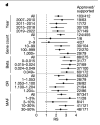Mij
Senior Member (Voting Rights)
Abstract
The cost of drug discovery and development is driven primarily by failure, with only about 10% of clinical programmes eventually receiving approval.
We previously estimated that human genetic evidence doubles the success rate from clinical development to approval.
In this study we leverage the growth in genetic evidence over the past decade to better understand the characteristics that distinguish clinical success and failure. We estimate the probability of success for drug mechanisms with genetic support is 2.6 times greater than those without. This relative success varies among therapy areas and development phases, and improves with increasing confidence in the causal gene, but is largely unaffected by genetic effect size, minor allele frequency or year of discovery.
These results indicate we are far from reaching peak genetic insights to aid the discovery of targets for more effective drugs.
LINK
The cost of drug discovery and development is driven primarily by failure, with only about 10% of clinical programmes eventually receiving approval.
We previously estimated that human genetic evidence doubles the success rate from clinical development to approval.
In this study we leverage the growth in genetic evidence over the past decade to better understand the characteristics that distinguish clinical success and failure. We estimate the probability of success for drug mechanisms with genetic support is 2.6 times greater than those without. This relative success varies among therapy areas and development phases, and improves with increasing confidence in the causal gene, but is largely unaffected by genetic effect size, minor allele frequency or year of discovery.
These results indicate we are far from reaching peak genetic insights to aid the discovery of targets for more effective drugs.
LINK

